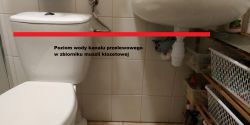

Czy wolisz polską wersję strony elektroda?
Nie, dziękuję Przekieruj mnie tam
Zbych034 wrote:Maybe not, he will have to wash his toilet bowlThis may be unacceptable.

Zbych034 wrote:This solution results in very dirty toilets. This may be unacceptable.
8850 wrote:@ta_tar: if you look at the photo, there is a pipe sticking out of the wall with a closed cold water supply to the toilet tank. Just turn off the water supply and pour dirty water from the sink into the tank.
ta_tar wrote:So what will you do if the tank is empty because no one used the sink and you need to rinse the bowl?
8850 wrote:@ta_tar: if you look at the photo, there is a pipe sticking out of the wall with a closed cold water supply to the toilet tank. Just turn off the water supply and pour dirty water from the sink into the tank.
I don't have access to the roof, I'm only interested in installing a sink and flush at the moment. In the photo below I have marked the water level of the overflow element. Is there any?/ Can I use a pipe reduction running under the washbasin to the siphon and then through a hose, e.g. a garden hose, into the toilet tank. Water from the hose under the washbasin can enter the cistern tank through the plug on the left side of the cistern. On the right side, instead of a cap, cold water from the water supply is connected. It looks like you don't need to use any pump based on the water level.

arekb81 wrote:Why mess around when there are ready-made solutions?
Link